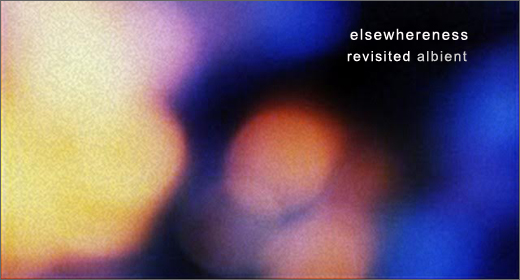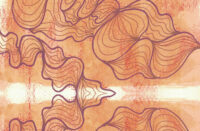Elsewhereness revisited is an occasional feature documenting the drift at the margins: ambient gasbagging, ’tube-d, ’cloud-ed, and ’camp-ed up, complete with companion mix, Elsewhereness revisited #5.
Now near-veterans with a back catalog on Infraction, Own, Barge and Students of Decay after s/t EP (Highpoint Lowlife, 2007), Pausal stop off at Dronarivm. A Touched Music request to perform in Pembrokeshire prompted the New Forest’s Finest to commune in a local hall to rehearse with a new setup of looped turntable, voice mics and synths, yielding a new sonic space that helped shape Avifaunal; viz. the volume variation and exploration of “Murmuration”’s micro-symphonic elevation as heard here, accruing interwoven strands in a steepling sprawl of tripartite but contiguous parts, moving from “I”’s susurrating mist to psyched-out sidekicks, “II” and “III.”Also assembled from session edits are “Spiral”‘s caliginous swirls and “Soar”’s serene synth-scapes, “Scatter”’s rapture of metals nestled between. It’s as if the heavier textured drones (Forms, 2012, Sky Margin, 2013) were fused with lighter pastoral romantic twins (Lapses, 2010, Along The Mantic Spring, 2014).
With the sense of season increasingly errant in our current climate, we can thank Constellation Tatsu for regular reminder of seasonal shift in the form of its quarterly collection. The latest Spring Batch includes Fear is the World, ‘Vanilla folk. Colourful noise. Chocolate ambient’ Russia’s Atariame; Conversions, wistful atmospherica capturing ‘a mental state of drifting in and out of sleep’ from Stockholm’s Echolog; Strange Lagoon Found At Nightfall, gentle aquatic hi-key drone from another Stockholmer, Fluorescent Heights. Best of the batch is The Elevated Quiet, brownian motion drone-bient from Chicago’s Forest Management.
File under ‘Oceanic’: Keith Berry‘s S I M U L A C R A (Infraction) recycles sources used on Elixir (Invisible Birds), indulging ‘a different take on material that had a strong pull on me, wanting me to return to it and explore the permutations that digital editing software allows.’ Insomniacs alert! A dose of sleep music from Polish ensemble How To Disappear Completely, Mer De Revs, ‘a study in deliberately soothing textures designed to give the listener space to find stillness and collapse into rest—late night lullabies,’ kept simple, with minimal gear. Previously HTDC (and FOG) deconstructed and rethought pieces from Dusk Union for the less soporific Reunion, ‘an album that can take on different lives when played soft or played loud […] that attempts to display nostalgia and the beauty in things that are worn and decayed,’ mostly made with overprocessed and overdriven guitars, bathed in hypnotic layers of distortion (insert list of knackered analog and vintage gear). ‘In a shattered world of washed out sounds and faded memories. Where dusks and twilights linger, and midnights stay.’ Yay!
https://youtu.be/LnX5OMtcQoQ
Spain’s Archives has a couple of goodies, a quiet gem from Yoyu, located in the Canadian Prairies, whose Ordinary Moon is a debut of ‘inspired heart songs and field recordings from the forests of Manitoba,’ and Purl’s Emptiness Is Form, remixes of Ludvig Cimbrelius‘s project’s previously Archived Form Is Emptiness from Logic Moon, Powlos, Moshimoss, Darren McClure, SVLBRD, and the Purl-y King himself.
Update from Shimmering Moods: Gallery Six follows SM debut Gasansui (bundled here) with Vibrancy, whose cover art sets the tone—a kind of color-saturated elemental isolationism awash in aqueous vibrant forms. Hidekazu Imashige proffers: ‘Let’s say, I hold a pen, she pours a cup of coffee. If we look down at them, they are squirming, they are all overflowing, and slightly vibrating.’ Cheers, Hide. Sweden’s Snufmumriko‘s At First Light (igloo-‘view) has a teeming trip through oneiric electro-acoustica, turntablist tweaks and found sound, bespeaking ‘dawn, new beginnings, […] the first steps on a new journey.’ By-passing the shy piano vignettes of Rime Trails‘ Solstice, and gentle loops of øjeRum‘s Naar Vi Vaagner, an Audio.Visuals.Atmosphere. tape reissue invoking ‘snowbound huts, weathered stones, colder winds, a hushed creek, and the occasional glimmers of the winter sun,’ we find Andrew Tasselmyer standing on the shoulders of Walter Benjamin, whose ‘The work of memory collapses time’ inspires him: ‘My reflection doesn’t reveal frozen, sequential timestamps; rather, these experiences live, breathe, and resonate even more today than they did when they occurred. Time collapses.’ Resonant Moments across the US, Canada, China, India, and the Caribbean are captured by field recordings—which also feature heavily across the Philadelphian ambienteer’s Presence (1, 2, 3).
‘Music is liquid architecture; Architecture is frozen music,’ said Goethe, and who are we to argue? The earliest examples of sound design stem from the interaction of human voice and various architectural spaces for worship and ritual. And such sonic reflections seemingly piqued Chihei Hatakeyama in his meanders through Turkey’s mazy bazaars; inspired by how sounds emerged and decayed within the interweaving pathways, ‘acutely aware of how architecture shapes sound and in doing so effects the very nature of music’s resonance,’ he sought to simulate all this in creating Mirage (Room40); new processes and transformations expanding his compositional approach, along with infusions of Turkish field finds, contributed to this culmination of his interest in the ‘phenomenology of music and architecture.’ “Starlight and Black Echo” trails.
Yann Novak’s Surroundings (Line) captures a site-specific performance for the Hamon Observation Tower at SF’s de Young Museum; using its architecture as platform, he incorporates field recordings from Golden Gate Park and synthesized sounds within them mirroring the two locations’ symbiosis to create a deep listening environment—a quiet array of field sounds seeping through layered synth drones. Novak also curates Tobias Hellkvist‘s Forest Psalms (Dragon’s Eye), conceptually similar in its anchorage in fields at heart and music on top, purporting to explore awareness in different spaces, to prompt ‘a state of mindfulness, total relaxation, and focus.’ Opener “The Driver vs. The City,” for example, blends fragments from the past with recordings from around Sweden and Denmark. Inspired by a California forest hike where he ‘came to experience a rare kind of stillness and desolation which really fascinated me,’ he goes on ‘most of the music I make is some kind of attempt to recreate moments like these for me to revisit.’ Can we join in?! Further fine findings from this Hell Kvist are the miniature, 24th Impulse (Éter), and the vast Skimmer with US Dronemeister, Ben Fleury-Steiner.
Athens-based Sound In Silence hosts three releases by moshimoss & stabilo, Anthéne, and (ghost). Browse through their bandcamp yields Wil Bolton, Caught in the Wake Forever, North Atlantic Drift, and Good Weather for an Airstrike inter alia. FIIEII splits two leading low-lights of Japanese ambient, moshimoss aka Kosuke Anamizu with fresh edits of two older tracks of delicate and ethereal construction, and stabilo aka Yasutica Horibe with a pair of pensive yet lush drones. Differing aesthetics mutually complement, four interwoven pieces forming into a single suspension. Brad Deschamps‘ stock-in-trade as Anthéne (or part of North Atlantic Drift) is a kind of shimmering quiet-storm spatialism, and Orchid adds another to his catalog of guitar études with discreet textural elements articulating an introspective mood. Denver’s (ghost) shows his more beatless ambient side (vs. his n5MD output) on The First Time You Opened Your Eyes, a single long-form sprawl of droning lushness that slowly grows to bloom in a more melodic habit with haunting overtones.
No Death x Sangam have been brewing up some strong stuff at BLCR Laboratories, now released in Waiting At The Gates—a slow release of spectral elegies under heavy vaporwave influence. The sound of sulky synth wizards with their chilly drones, hypnagogue loops from days of electronic future-past, coming on like a doleful dreampunk cut’n’shut of the synthetic wow and saturation flutter of 2 8 1 4 (his Dream Catalogue hosted Sangam’s You Forget This) with Burial’s urban twilight. He also fills up one side of a split (with khoven) with Remnants, seven dark-lit strips of oneiric glam-gloom via Kansas’s ∆LITH, ‘the product of soundwaves and the fusion of dark matter in the realms of ethereal cyberspace.’
Having computed 20 albums since its launch, Whitelabrecs puts out a first compilation, Whitelabsounds. Harry Towell assembling a score of top drawer types like Offthesky, Maps & Diagrams, The Green Kingdom, Wil Bolton, and lesser knowns for ‘a mood board of the various shades of modern Ambient music, with darker drones concocted from electronics and light noise sitting alongside electro-acoustic pieces.’ Whole transcends parts sum, reflected by the cover photo of tessellating mosaic tiles from Pompeii; ‘some tiles are worn and disintegrated whereas some are smooth and clear.’ Try “Gentle Sound For A Broken Horizon” by David Kolhne, shadowy figure behind Granular Canvas, one of the Labs’ best: ‘he strips away all narrative in favour of allowing the sounds, noises and tones a voice in which to tell a story’ via soft and hard synths plus custom-built instruments mutated with granular synthesis into fetid microsound settings; ‘not so much pictures or paintings as they are colour washes, as deep strokes of blue, grey and green dominate the palette […] a sort of sea-spray shade […] a suggestion of pressure yet somehow, a sense of relaxation.’ Sling the wooze!
Rafael Anton Irisarri and Leandro Fresco’s mutual admiration society sparks La Equidistancia (A Strangely Isolated Place), a collaboration where Fresco creates specific sounds based on concrete directives from Irisarri—the kind of warmth and sound color distinguishing the Argentine’s work from first outing on Pop Ambient 2003 right up to last, El Reino Invisible (2015). This melodic sensibility becomes a defining element in Irisarri’s sound design, taking it into new territory, the heft of his previous A Fragile Geography (2015) presaging the depth soundings found here. Well versed in production partnerships (cf. Orcas and Gailes), heavy semiosis is effected via building tension and steepling atmos, Fresco softening Irisarri’s harmonic distortion, effect pedals, and (crusty 1⁄2“) tape loops. ‘I really love that grainy aspect you can hear in the music, degraded in a way, like it’s been through some rough patches,’ these ‘printed and encapsulated in the grooves of the vinyl.’ Al Fresco!
Stereoscenic, closely related to the Ambient Sleeping Pill internet radio station, offers ‘lush environments painted with sound… avoiding depressing, dark, or new-age,’ with the likes of poemme’s Arboretum a perfect exhibit. And Hilyard‘s Repose too—‘an ambient experiment created with the intention of aiding sleep and meditation. The music is meant to replace the space in our mind taken up by thoughts anxiety and worry.’ You get the picture, and the appeal; the artist apparently calibrated his instrument’s tuning to 432hz to give it a different feel, though he admits, refreshingly unpretentiously, ‘I cannot say with scientific or historical confidence that tuning in that way is truly more beneficial to mind body or spirit.’ Hilyard’s previous, Asleep in Amber, is even better, and look into tsone‘s Intimate Haze and Koen Daigaku’s Forest in Full Bloom too.
Somewhere (Instant Classic) sees Tomasz Bednarczyk fulfil his vision of New Rome, collecting a lot of ‘[…] sounds [are] deeply rooted in Eastern European culture with all its ambitions’ while creating ‘a link to a time when I released my first records but I filtered it out through my later experiences.’ Resuming where previous Nowhere (igloo-’view) left off, it’s not so much ‘Ambient,’ he says, ‘more of a full-blown ambient deconstruction reminiscent of Tim Hecker’s sonic experiments.’ More like a 90s ambient electronica update to these ears, though we can agree it ‘brings to mind darker soundscapes’ (though, note, anything on a ‘doleful-wistful-elegiac’ cline would do more nuanced service than dull default, ‘dark’).
https://youtu.be/YMqR1Azi5VA
A Shadow in Time‘s two pieces offer contrasting views of the vertiginous juxtaposition between indeterminacy and intention explored by William Basinski. The title track is a richly layered piece for the vintage Voyetra 8 synth that showcases his compositional prowess, while “For David Robert Jones” is a loopy soup of re-purposed cat-chewed tape remains complete with Bowie-referencing (it’s a tribute) sax offence (it jars) that’s a near parody of the sonic entropy of Basinski’s bent. “Shadow” is the less-is-more star here, opening in slow-mo wisps of glistening high harmony and shifting murk, gesturing towards the infinite before hollowing out, glassine highs fading away like a dusky comet tail before slow fall inward dissolved in tape hiss.
Liam Blackburn, aka Indigo/Akkord (with Synkro), re-oriented post-d’n’b towards ambient and tribal/ethno experiment for Ancestral Voices, returns, following up Night Of Visions (Samurai Horo, 2015), ‘the aural equivalent to an Ayahuasca trip’ (review, Norman), with Divination (Horo). It’s just as deep but subtler, largely foregoing beats for a rapture of metals, chimes, drones and low-end pressure. More Deep Listening Bass Music than doom-mongering dark ambient, though it does qualify for the overused tag (‘dark,’ that is). While Night Of Visions was inspired by experience in the Amazon, ‘loaded with a taut energy that whispers tales of shamanism and transformative life experiences,’ endowed with ‘mystical atmosphere,’ this feels closer to ancestral home. Still Blackburn’s art is all about voicing sound space, spectral to visceral: abyssal chord yawn and reverb vapor-trails, high-end quivers and shivery timbres.
Bundled for warmth: Steve Pacheco out of Santa Fe & LA has Constellate ‘form into a cluster or group’ tranches of tones, slowly tilting their particulate texture to catch glimmers of light—on Belgium’s Dauw, which aims ‘to combine the graphic work of Femke Strijbol and some music we like […] to create an unique hand-made piece of art that flatters both the ear and the eye.’ And Before We Dive by Altars Altars has German ambienteer Moritz Leppers dive deeper than the more low-light Small Hours (Home Normal, 2016) in a ‘collage of youthful memories fashioned from warm aqueous drones and marine sounds,’ offering ‘hours to drift, to explore, to gaze at the expanse of endless horizons or muse on what lurks in dark places or teems among the cloudy depths’ that snags a desire for the aquatic life. RIYL: Jacques Cousteau!
Juha-Matti Rautiainen, having cut off a fingertip—for a bassist somewhat limiting, honors his error as a hidden intention (OS); figuring ‘the most intriguing music is born when you set limits to yourself,’ he finds a way to The Endless Now – Music for Stagnation via a different mode of play and an array of FX. Tape Loop Orchestra is back with a blissed-out’n’blighted flight of manipulated micro-orchestral fancy, Held Against the Light. Berlin-based rohs! records has a nyp from Sardinian curator, Andrea Porcu, Schorre—after the Belgian national park from which he captured most of the field recordings here ‘for self-meditation.’ Last, Arne Weinberg mobilizes his Valanx for more drone and dark ambient constructs, building on The Towering Pillars with 2×20-min. tracts of abstract drift, Radiant Orbs of Abzu (Cromlech), invoking the Sumerian god of fresh water—the primeval sea below the void of the underworld and the earth above. Are you listening, Abzu?!





















